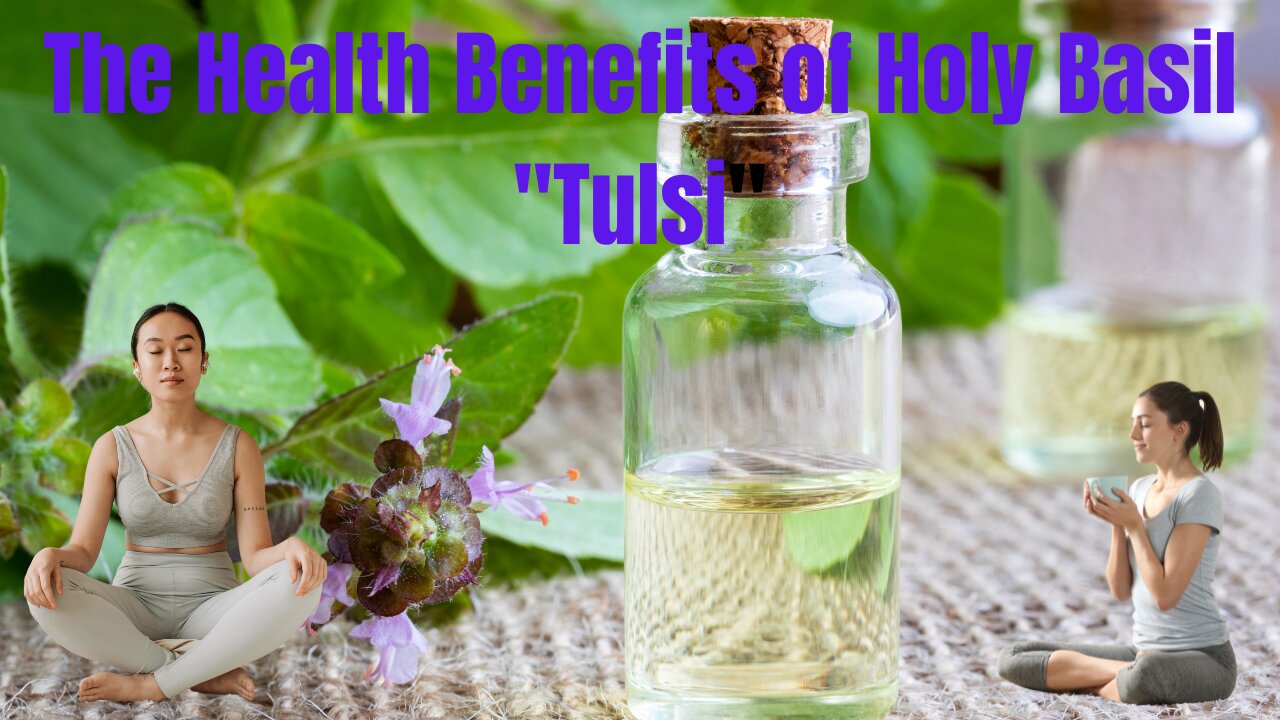Premium Only Content

The Health Benefits of Holy Basil "Tulsi"
Holy Basil, also known as Tulsi, is native to Southeast Asia and is called the “Queen of Herbs”. It has a history in Indian medicine as a treatment for many conditions, from eye diseases to ringworms. From the leaves to the seed, holy basil is considered a tonic for the body, mind, and spirit.
Holy Basil is used for treating different conditions such as:
bronchitis.
malaria.
diarrhea, nausea, and vomiting.
eczema.
stomach ulcers
Take the tincture internally for eye diseases.
And topically for insect bites.
All parts of the holy basil plant act as an adaptogen. An adaptogen is a natural substance that helps your body adapt to stress and promotes mental balance.
The concept of an adaptogen is a holistic approach. But scientific research shows that holy basil has pharmacological properties to help your mind cope with many types of stress.
The source of your stress can be:
chemical
physical
infectious
emotional
In the case of physical stress, holy basil is known to increase endurance. Peoples who took holy basil and went through environment-induced stress scenarios showed:
enhanced metabolism
improved swimming time
less tissue damages
lower stress levels in loud environments
Human studies saw reduced:
stress
sexual problems
sleep problems
forgetfulness
exhaustion
According to Medical Journals, holy basil has antidepressant and anti-anxiety properties comparable to diazepam and antidepressant drugs.
One study found that people who took 500 milligrams (mg) of holy basil each day felt less anxious, stressed, and depressed. People also felt more sociable. Ayurvedic practitioners recommend drinking holy basil as tea using the leaves. And since it’s caffeine-free, it’s OK and even recommended to drink daily. The act of drinking tea can be ritualistic and as calming as yoga. It fosters clear thoughts, relaxation, and a sense of well-being. Holy basil is also high in antioxidants and helps your body detox. Holy basil can protect your body against toxic chemicals. It may also help prevent cancer by reducing the growth of cancerous cells.
Extracts made from its leaves are thought to boost wound healing speed and strength. Holy basil is:
antibacterial
antiviral
antifungal
anti-inflammatory
And analgesic (better known as a painkiller)
Some people even use holy basil after surgery to heal and protect their wounds. Holy basil increases your wound’s breaking strength, healing time, and contraction.
Breaking strength is referred to as how much pressure or weight a wound can take before it breaks.
Research shows that holy basil may work against infections and wounds, such as:
mouth ulcers
keloids
raised scars
acne
If you have prediabetes or type 2 diabetes, all parts of the holy basil plant can help reduce your blood sugar.
Studies have shown that holy basil can help prevent symptoms of diabetes such as:
weight gain
hyperinsulinemia, or excess insulin in the blood
high cholesterol
insulin resistance
And hypertension
Talk to your doctor before adding holy basil to your diet. If you’re already taking medications to control blood sugar, it may lower your blood sugar levels even more.
Since holy basil targets metabolic stress, it can also help with weight loss and cholesterol levels. One study found that the oil in holy basil (eugenol) lowers stress-induced cholesterol levels. By drinking holy basil as tea, you will be able to lower stress, anxiety, and inflammation. As an adaptogen with anti-inflammatory and antioxidant properties, holy basil provides all of these benefits. It can even help people with arthritis or fibromyalgia. Holy basil can counteract the effects of stress-induced ulcers.
It naturally increases your stomach’s defense by:
decreasing stomach acid
increasing mucus secretion
increasing mucus cells
And extending life of mucus cells
Many drugs for peptic ulcers have side effects and can cause discomfort in some people. Holy basil may be a preferred alternative. A study showed that holy basil reduced both the number and index of ulcers significantly in two-thirds of participants.
-
 LIVE
LIVE
Candace Show Podcast
1 hour agoBREAKING NEWS! I’ve Been Keeping A Secret. | Candace Ep 208
5,214 watching -
 LIVE
LIVE
Bitcoin News Alerts
2 hours ago"75% Chance Big Beautiful Bill Eliminates Capital Gains Tax On Bitcoin"
425 watching -
 2:04:40
2:04:40
The Quartering
4 hours agoIdaho Shooter NAMED, Social media Scrubbed W/ Owen Shroyer!
221K17 -

Nerdrotic
19 hours ago $5.65 earnedTemu WWIII Canceled Pride Month, but Not Ironheart - Nerdrotic Nooner 497
54.4K7 -
 1:04:26
1:04:26
Jeff Ahern
1 hour agoMonday Madness with Jeff Ahern
17.6K6 -
 LIVE
LIVE
RalliedLIVE
3 hours ago $2.53 earnedSHOTTY BOYS WARZONE CHALLENGES
266 watching -
 LIVE
LIVE
StoneMountain64
3 hours agoPUBG maximum LOGIC + STRATEGY for the WIN
89 watching -
 57:20
57:20
HotZone
8 hours ago $0.36 earnedWar Continues as Israel Strikes HARD in Lebanon and Iran
15.5K10 -
 3:07:37
3:07:37
Viss
4 hours ago🔴LIVE - Dominating The Battleground with Tactics! - PUBG
19K1 -
 1:38:15
1:38:15
Russell Brand
4 hours agoGlastonbury Goes RADICAL - Police Probe 'Death to the IDF' Chant - SF605
208K20